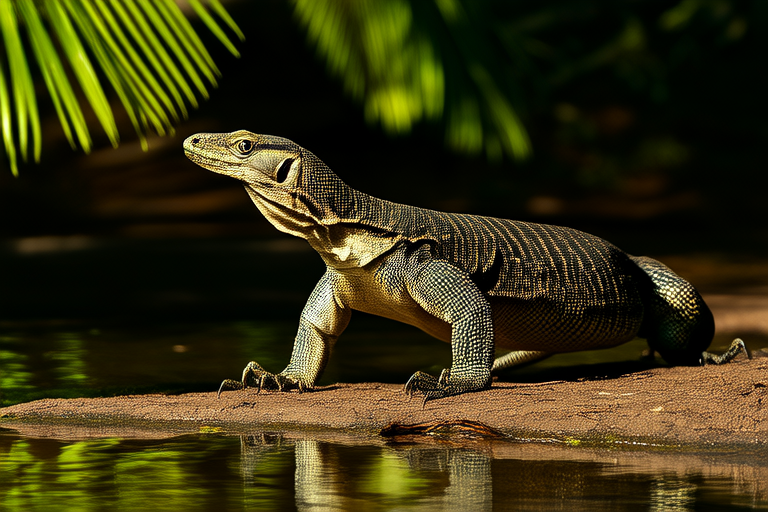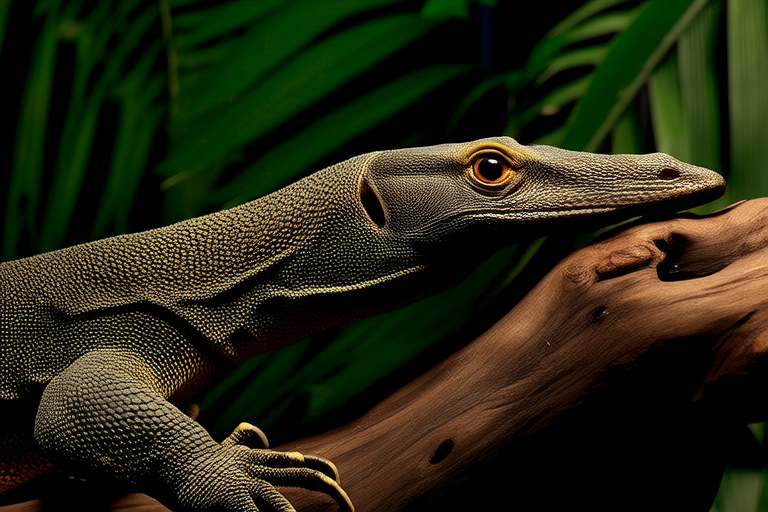
How to Create the Perfect Habitat for Your Water Monitor at Home
Water monitors (Varanus salvator) are fascinating reptiles known for their intelligence, agility, and adaptability. These animals thrive in environments that closely mimic their natural habitats, which include tropical forests, mangrove swamps, and riverbanks. Creating the perfect habitat for your water monitor at home requires careful consideration of several factors, including enclosure size, lighting, heating, substrate, water area, diet, and safety measures. This guide will walk you through the steps necessary to ensure your water monitor has a healthy, stimulating living space.
Enclosure Size
The first step in creating an ideal habitat for your water monitor is selecting an appropriately sized enclosure. Water monitors are large lizards that require ample space to move around comfortably. A minimum enclosure size of 6 feet long, 3 feet wide, and 4 feet tall is recommended for a juvenile water monitor. As they grow, the enclosure must be expanded; adults may need enclosures that are up to 12 feet long by 6 feet wide by 8 feet tall. Ensure the enclosure is secure, with a tight-fitting lid to prevent escape.
Lighting Requirements
Proper lighting is crucial for the health of your water monitor. They require both UVB light and heat lamps. UVB light helps the lizard synthesize vitamin D3, which is vital for calcium absorption and bone health. Use a high-quality UVB lamp designed for reptiles, and position it so that it provides adequate coverage over the basking areas. Replace the bulb every six months, even if it still appears functional, to ensure maximum effectiveness. Additionally, provide a heat lamp to maintain the correct temperature gradient within the enclosure.
Heating and Temperature Control
Water monitors are ectothermic, meaning they rely on external sources to regulate their body temperature. The enclosure should have a temperature gradient ranging from 85°F to 95°F (29°C to 35°C) during the day, with a cooler nighttime temperature of around 75°F to 80°F (24°C to 27°C). Place the heat source at one end of the enclosure to create a basking spot, allowing the monitor to thermoregulate effectively. Use a reliable thermostat or rheostat to control the heat lamp’s output and avoid overheating.
Substrate Options
Selecting the right substrate is important for the health and comfort of your water monitor. Many owners opt for a combination of substrates to cater to the lizard’s varied behaviors. A mix of coconut fiber, cypress mulch, and play sand can provide a naturalistic appearance and allow for burrowing. Avoid substrates like wood shavings, as they can irritate the lizard’s skin and respiratory system. Ensure the substrate is deep enough for digging but not so deep that it poses a risk of ingestion or impaction.
Water Area Specifications
Water monitors are semi-aquatic and require access to clean, fresh water for drinking and bathing. The water area should be large enough for the monitor to fully submerge itself, with depths ranging from 18 inches to 3 feet depending on the size of the lizard. Ensure the water is regularly changed to maintain hygiene, and consider adding a filtration system to keep the water clean. A ramp or shallow area should be provided to help the monitor enter and exit the water safely.
Diet Considerations
Feeding your water monitor a balanced diet is essential for its overall health. In the wild, water monitors are opportunistic feeders, consuming insects, small mammals, birds, fish, and eggs. At home, you can offer a variety of pre-killed prey items, including mice, rats, chicks, and feeder fish. Juveniles should be fed daily, while adults can be fed every other day. Supplement their diet with calcium and vitamin D3 powders to support proper growth and bone health. Always remove uneaten food promptly to prevent contamination.
Safety Measures
Water monitors are powerful and fast-moving animals that can pose a risk to themselves and others if not handled properly. To ensure their safety and yours, always supervise them when outside of their enclosure. Provide plenty of climbing structures and hiding spots within the enclosure to give them opportunities to exercise and explore. Regularly check for any signs of stress or discomfort, such as excessive hiding, reduced appetite, or abnormal behavior.
Maintaining Hygiene
Keeping the enclosure clean is vital for preventing infections and diseases. Remove waste and uneaten food daily, and perform a thorough cleaning of the enclosure once a week. Use a safe disinfectant specifically formulated for reptile habitats, following the manufacturer’s instructions carefully. Allow the enclosure to dry completely before replacing the substrate and furnishings. Regularly clean the water area and replace the water to maintain hygiene.
Ensuring a Stimulating Environment
To keep your water monitor mentally and physically stimulated, provide a variety of enrichment activities. Offer different types of climbing structures, such as branches, rocks, and logs, to encourage exploration and exercise. Rotate toys and objects periodically to prevent boredom. Some owners also introduce puzzle feeders or hide-and-seek games to challenge their monitor’s problem-solving skills. Providing a diverse and engaging environment will help keep your water monitor healthy and happy.
Conclusion
Creating the perfect habitat for your water monitor involves replicating aspects of their natural environment as closely as possible. By providing an adequately sized enclosure, appropriate lighting and heating, suitable substrate, a proper water area, a balanced diet, and safety measures, you can ensure your water monitor thrives in captivity. Regular maintenance, hygiene practices, and enrichment activities will contribute to a stimulating and healthy living space for your pet. With thoughtful preparation and care, you can provide a loving home for your water monitor that supports its physical and mental well-being.






